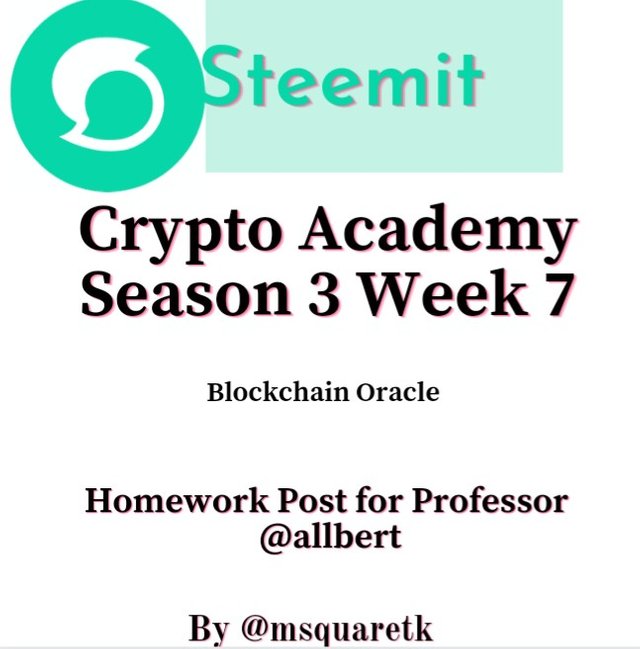
Hello everyone. It is a brand new week again.
Week 6 was awesome, and I believe week 7 will be glorious, too. I'm happy to submit this homework post to professor @allbert. He taught "Blockchain Oracle." The course was taught in a very simple way which anybody can understand. Thank you, Prof.
At the end of the lecture, Prof. ask us to develop a detailed post on a blockchain oracle which must cover the points below:
1- History and Description. Does it have any token or cryptocurrency associated? Explain.
2- Functionalities and real-life applications.
3- Pros and Cons.
4- Future developments and new projects
So I am going to develop a detailed on a blockchain oracle. Follow me closely.

BLOCKCHAIN ORACLE
What is Blockchain Oracle?
The word "oracle" means a person through whom message is delivered to another person by a god. Oracle is a medium through which a message is delivered to a person.
So what is now blockchain oracle?
Blockchain Oracle is a medium that connects blockchain to the world. It is a third party between blockchain and the real and web world. Let's go deeper now. Blockchain oracles are third party services that provide information for smart contracts (Smart contracts are form of computer programs coded and which are expected to run on blockchain to execute and control various activities being done on block chains.) from the outside. These third party services provide information for smart contracts by verifying querying data from outside.
Blockchain oracles are liken to bridges that connects blockchain to the outside world.
The data which smart contracts of blockchain receive from the outside world is often referred to as "off-chain data." These data are very important for the function of smart contracts. By the help of trusted API's, the blockchain often find it easier to interact with the real world in order to get these data which are very important to smart contracts. It's pertinent to know that blockchain oracles are needed so blockchain can execute agreements.
Some of the examples of blockchain oracles adopted by blockchains are:
- Chain link
- Augur
- Brand protocol
- DIA (Decentralized information asset)
- Nest Protocol
- API 3 etc.
Now, I am going to talk extensively on DIA

DECENTRALIZED INFORMATION ASSET (DIA)ORACLE

Fig. 1: Picture of DIA
SOURCE
History and Description of DIA
Description
Decentralized information asset (DIA) is a type of blockchain oracle which allows blockchain to source for trusted data. The oracle targets to bring together data analysts, data users and data providers to provide verifiable and reliable data for blockchain technology. Dia provides a bridge between off-chain data and on-chain smart contracts.
DIA is an open source type of blockchain oracle for decentralized finance (De-fi). DIA utilities crypto economic incentive to provide data for market actors.
DIA was introduced to solve many problems of data which are not from real source that market actors have been exposed to. Most decentralized applications and data providers publish information or data which are not reliable, which are not from real source. This has led to lack of trust in digital asset information. But DIA saw the problem and solved them by providing reliable data for market actors
Many De-fi apps and CE-fi used DIA oracle' data. They use the data because DIA provides verifiable and trusted data.
History
DIA was founded in the year 2018. The project was founded by a group of people. Research shows that the group comprises about 12 people, where Paul Claudius, Michael Weber and Samuel Brack are the leaders of the group.
Paul Claudius was the the team lead for the project and is also regarded as the CBO. Paul studied in ESCP, Europe where he had his master degree in International management and had his bachelor degree in Passau University where he studied business and economics. Paul has worked for a company called nu3. The company is a nutrition company.
Weber is the CEO of DIA. He also studied in ESCP with master degree in management and had his bachelor degree in physics and economics in University of Cologne.
Barack is the CTO of DIA. Barack studied at Humboldt University of Berlin with a masters degree in computer science
The mission of the project is to build a system or platform where reliable and verifiable data will be provided to decentralized finance.
Let's see the image of DIA team in the screenshot below.
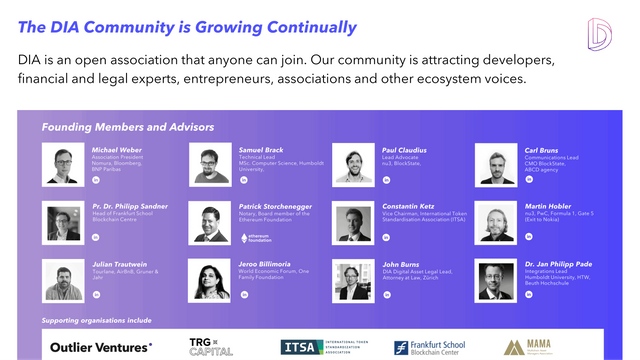
Fig. 2: Picture of DIA Team members
SOURCE
Also the picture below shows the road map of DIA

Fig. 3: DIA Road Map
SOURCE
By clicking this [whitelist](https://www.diadata.org/), you can read more about DIA.
DIA Token
DIA has a token called DIA governance token. The token is used to fund data collection and as well as data validations. There is an opportunity for users to use their tokens for staking, and at the same time, the historical data is open to anyone.
DIA has what is called the proof of truth or proof of use. This means that DIA governance token will be a reward for any smart contracts using DIA oracle and the reward will be on a daily basis.
DIA Token in Circulation
According to research, about 200million coins was minted at early days of the project. The organizers of the token sold 10 million token for a private sale, early Investors of the coin hold 19.5 million.
In August 2020, they offered what is known as "bonding curve sale" where 30 millions coins were sold. 19.8 million of the coin was burned and the remaining was sold to the public.
24 million coins was also given to the founders and the entire team. They locked up 25million coin for future use. In addition, 91.5 million coins was in the reservoir of the company. This will be unlocked every year.
DIA token uses ERC20. ERC 20 usually defines rules and regulations in which token which adopted it must operate. Without ethereum, DIA Token cannot function. Since this token works with ERC20, then the blockchain protocol which protects transactions of the token is proof of work mechanism.
Let's see the price, the rank and market cap of DIA token.
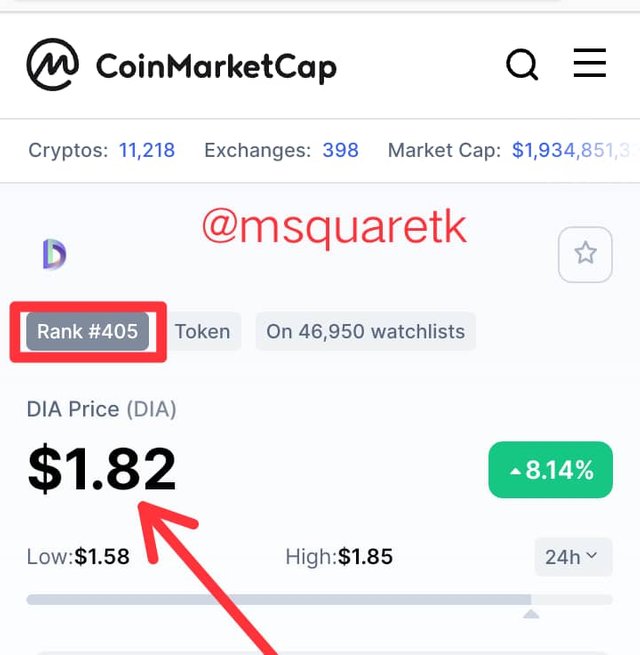
Fig. 4: DIA Rank and Value by Coinmarketcap
SOURCE
In fig. 4 above, we can see that DIA token is ranked 405 by coin market cap. And the price or value in as at the time of writing this post is $1.82.
Also, below is the screenshot showing the market cap of DIA coin.
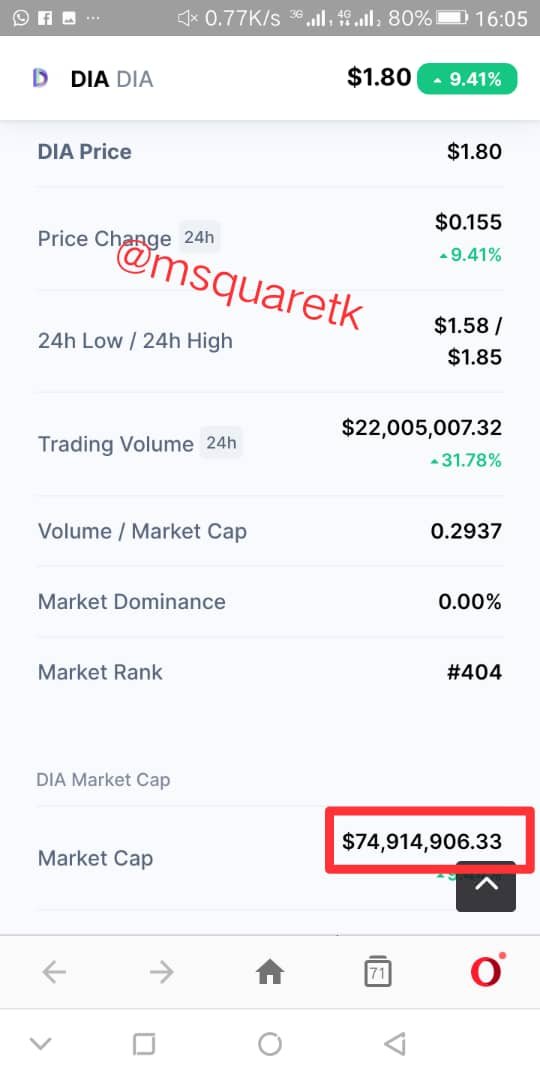
Fig. 5: DIA Market Cap by Coinmarketcap
SOURCE
As seen in fig. 5 above, the market capitalization of DIA coin is 74, 914,906.33
DIA token are listed on decentralized exchange platform and centralized exchange platform.
Examples of Centralized exchange platform where you can find DIA token are:
- Binance
- Bimart
- Kucoin
- OKEX
- Liquid etc.
Example of decentralized exchange platform where you can see DIA token are:
- Uniswap
- 1inc
- Mess
- SushiSwap.
The image below shows DIA atonomous distribution mechanism of DIA token.
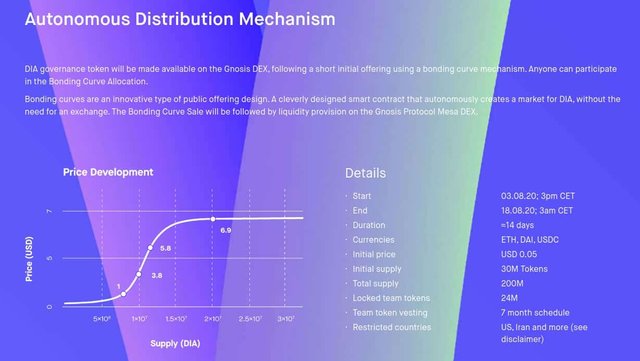
Fig. 6: DIA Distribution Autonomous Mechanisms
SOURCE
In August 13 -17th, 2020. DIA token was sold for 0.5USD and today, the valued of the coin worth $1.82. This shows that the coin has experienced significant growth over the years. Let see the screenshot below.
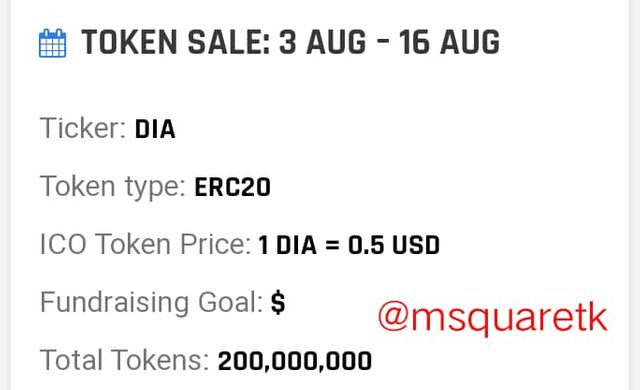
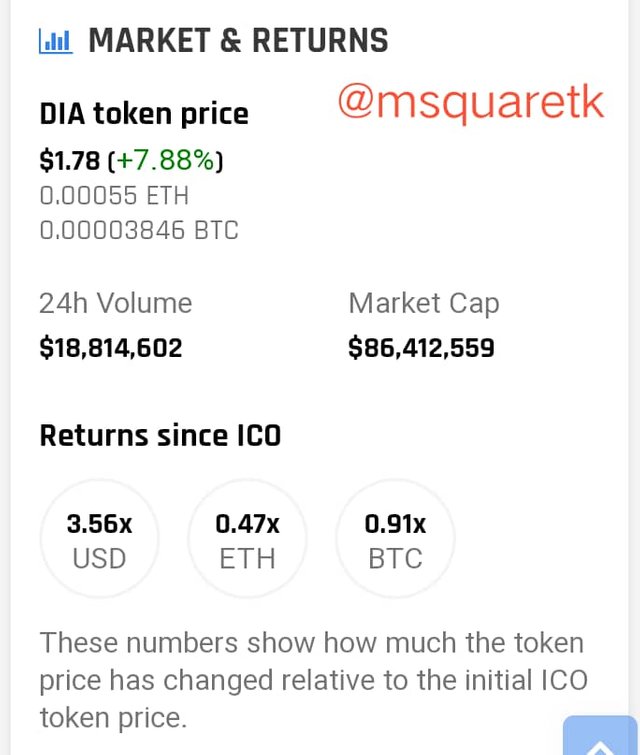

Functionalities and real-life applications of DIA
DIA is one of the oracles that's very useful when it comes to sourcing for reliable data outside the world.
How DIA Function
Requesting for Data
The very first thing to do if you are a stake holder and looking for some data which has not been published on DIA platform is to request for those data by submitting a ticket. It is pertinent to know that the ticket must be funded.Data Submission
Here, the data providers do their work by creating scrappers and also they must connect to API in order to be able to provide data which has been requested for.Validating Process
This process involves verifying codes that we're submitted using staking mechanism. It is the job of Data Analysts to verify these codes. If fault (s) is found in the submitted code, people can confront this errors or fault to find solution to them by staking their tokens.Storing Data
The next process is to store the data which has already been validated in an open source database. After this, it's then published on the platform.Usage
The data are now ready for use. People can access data either through on-chain, the oracle or off-chain, the API's. People can access the historical data free of charge, but for current and live data, they will charged their tokens.
Let's try to see the DIA architecture in the image below.
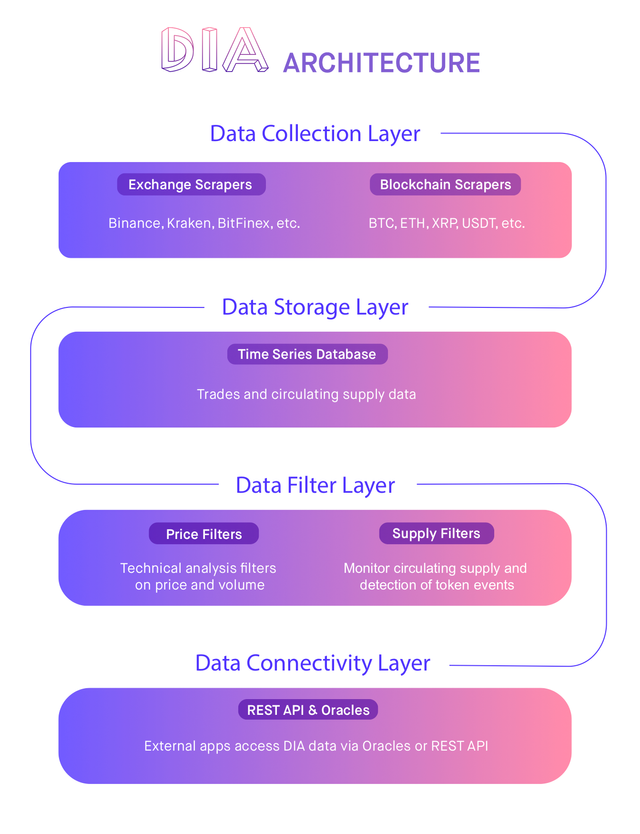
Fig. 8: DIA Market Architecture
SOURCE

DIA's Pros and Cons.
Let's quickly look at the advantages and limitations of this blockchain oracle called DIA.
Advantages
DIA is a type of blockchain oracle which operates based on the open source. That's, the data published are accessible and transparent.
Another advantage of this type of oracle is that , the data can be accessed through both the on-chain, which is the oracle itself and off-chain, the APIs.
People can access the historical data on DIA oracle and APIs free of charge. This is a very big help to people who wants to just work on a project and needs data.
The native token of the project DIA is listed both on centralized (e.g Binance, Kuicoin, Bitmart etc.) and decentralized (e.g Uniswap, 1inc, SushiSwap etc.) platform.
DIA provides data which are reliable and verifiable.
Another advantage of DIA is that the suppliers of Data are rewarded with a bounty once they complete their work.
The ability of DIA oracle to source for any kind of data being it on-chain or off-chain data makes it unique and very useful.
DIA provides data which can be integrated into any blockchain applications.
The data DIA provides are tailored ones. This means that the data can be fitted to meet ones desire.
Limitations
One of the limitations of DIA oracle is that the live data cannot be accessed free of charge. Anybody who is interested in knowing the current or live information about data will be charged with his token.
If there's any faults defected in the process of validating the code submitted, the holders of DIA token have to stake their coins in order to rectify the faults or error.
Those oracles that work on decentralized lending, yield farming etc., the pricing feeds must work off validated data streams. Otherwise, the system can give up money when it should not give money.
Because DIA is a token that uses ERC-20 which operates based on proof of work, the price of gas which is often used in performing transaction can be hiked by congestion. And this always leads to unnecessary delay in transaction and high transaction fee.
Also, ERC-20 always give a set of rules which the token must operate on. This means the token which uses ERC-20 must submit to the whatever rules ERC-20 lists.

Future developments and new projects of DIA Oracle
New Projects
On the 10th of June 2021, a new came out that DIA pioneer DRM for data right. DRM means digital right management. This development will enable data to be embedded straight to the digital collectibles.
This development will allow data originators to monitor their their data and if anyone wants to have access to it, he must mint the data or buy the NFT data rights.
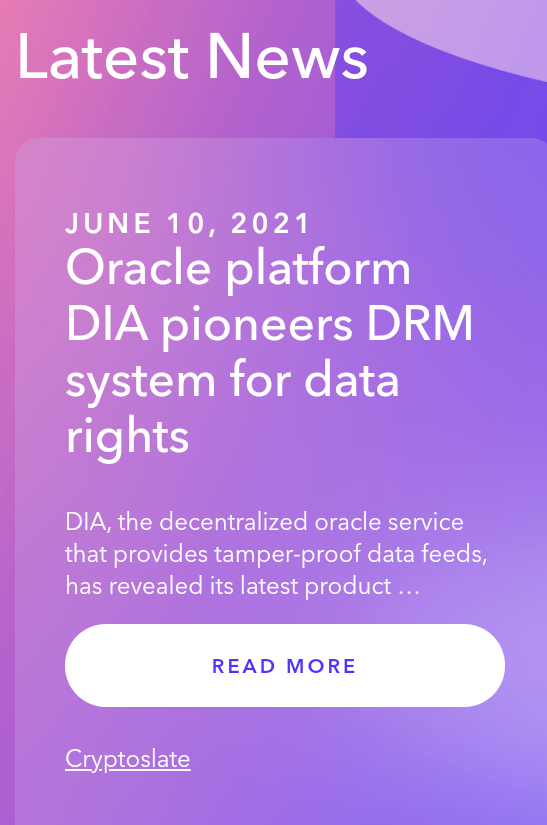
Fig. 9: News of DRM
SOURCE
On that same day, June 10, 2021, a news was published about how DIA introduces ARTs. ARTs means "Autonomous Right Token."
According to the news, this development ARTs is a new system of tracking data usage rights. And it done by capitalizing on the decentralisation benefits so as to create market infrastructure the will govern itself and a system that tracks accurately by the use of "Autonomous Rights Tokens".
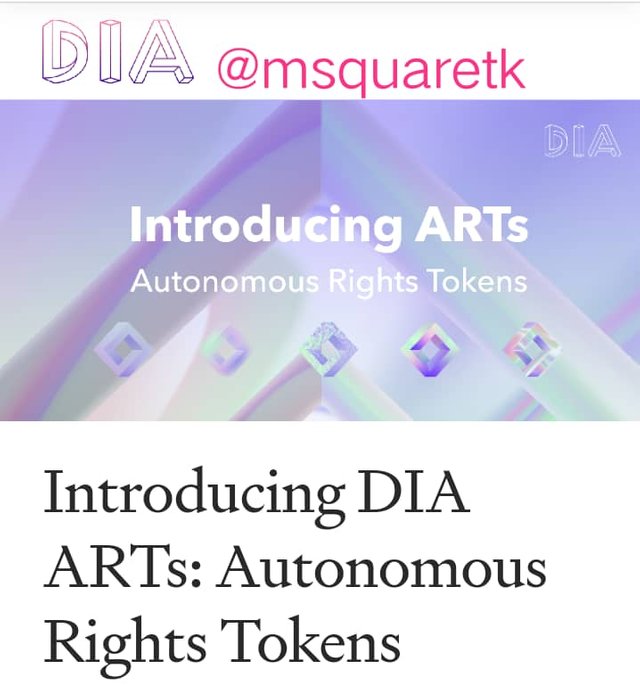
Fig. 10: DIA introduces ARTs
SOURCE
You can read more about the project here
Also, in this month of August, to precise August 3, 2021, DIA realized that as the Defi and cryptocurrency world evolves and continue to grow everyday, so there is need for stability so that the users can enjoy maximum stability and security. So, on that day, DIA provided price of the oracle to support xDai chain. This will ensure fast and scalable blockchain and in which the transaction will not subject to market volatility.
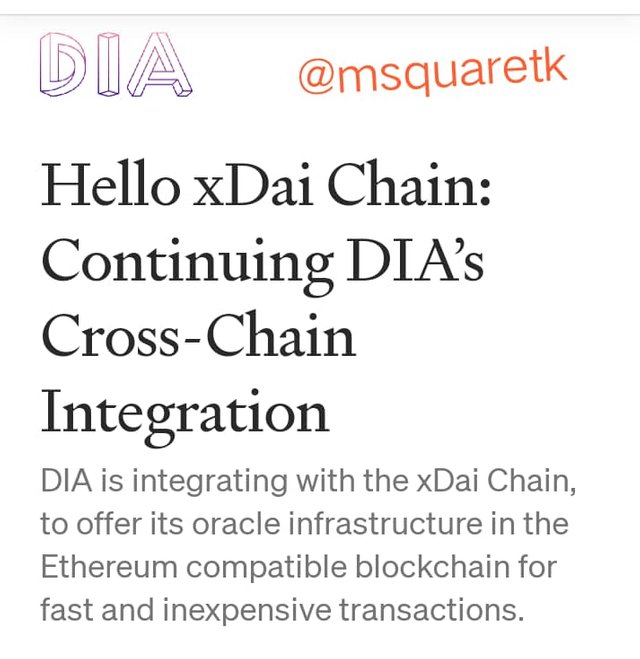
Fig. 11: DIA Integrated xDia Chain
SOURCE
Read more about the project here
Future Development
The latest news released just today, 12th August 2021 shows some developments DIA association are proposing.
In the news, DIA proposed aims to make the community and lab grow by realizing extra token which will make and help in more adoption of transparent and open-source data. It said that to achieve the goal, the DIA community Q4 2021 will commit about 12.5M DIA token from Q4 reservation to the token pool of DIA ecosystem.
The token pool will therefore be used in three areas, which are: marketing and operation, development of application and lab and community engagement.

Fig. 12: DIA August Update
SOURCE
Visit here to read more about this update.

Conclusion
Blockchains oracles are third parties services which provides information in form data from outside world either the world of web or real world to blockchains. Oracles are very important because blockchain can not verify activities on its own. Smart contracts which is the digital agreement between users which blockchain employed needs data so it can verify the series of transactions and execute some specific conditions on the block chain. These data are now provided by third parties, called blockchain oracles.
Decentralized information Asset (DIA) is a type of blockchain oracle. It is regarded as an open source oracle which allows people to source and share data. DIA provides both on-chain and off-chain data. DIA is unique Because it is open source type of oracle meaning that the data are available for public. Although the historical data are only data that are free but the live data are paid for by charging users who is interested I the data his tokens.
Thanks to Professor @allbert , I have been able to do research extensively about blockchains oracles. I have learnt how useful they are to blockchains. I'm glad I attended the lecture and it has added a whole lot to me.

Reference Article
Reference Article
Reference Article

CC: @allbert
Written by @msquaretk
Hello, @ Thank you for participating in Steemit Crypto Academy season 3 week 7.
Downvoting a post can decrease pending rewards and make it less visible. Common reasons:
Submit
Thank you, Prof. @allbert. I'm glad I attended your class.
Downvoting a post can decrease pending rewards and make it less visible. Common reasons:
Submit